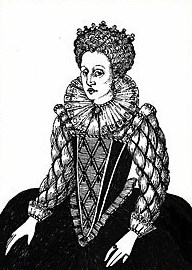|
The Elizabethan Era was distinguished by its abundance of great personalities, among them Sir Francis Drake; William Cecil; Lord Burghley; Sir Humphrey Gilbert; and Sir Walter Ralegh. But none compared with Elizabeth Tudor, who was able to use her gender, which should have been a hindrance, to her advantage.

Vicki Wallace
Elizabeth grew up with intrigue. Her mother and another of Henry's wives were executed. Henry VIII did not live to see his son come of age, and a regent ruled the country in the name of the young king. With the accession of Edward VI in 1547, the Protestant faction assumed control. His half-sister Mary remained Roman Catholic, however, and became the center of that faction. Ambitious people including Thomas Seymour, plotted to increase their own power and attempted to involve Princess Elizabeth in their schemes. Eventually Seymour's plots collapsed and he was executed. Elizabeth herself was implicated in the intrigue. With the death of Edward VI in 1553 there was a great danger of civil war. Mary, the Catholic daughter of Henry VIII, became queen, and married Phillip II of Spain, placing the nominally Protestant Elizabeth in a more precarious position because as heiress presumptive she was the hope of the Protestant and anti-Spanish faction. After Wyatt's rebellion in 1554, Elizabeth was sent to the Tower of London. Later she was confined for a year at the palace at Woodstock.
Elizabeth learned valuable lessons from her sister's reign. The choice of a husband for a reigning queen would be an issue of great moment, for in a male-dominated world her husband would become an important figure. To marry an alien ruler such as Philip II would put England under foreign domination and embroil the country in continental squabbles. To marry one of her own subjects would ally her too closely with one English faction or another. Elizabeth also saw that an heir would become the rallying point for any of several large groups of discontented subjects. She therefore kept open her options about marriage and an heir until the end of her reign.
As it became obvious that Mary would die childless, pressure was put upon her to name Elizabeth as heir. Philip II supported Elizabeth's claim. Thus it was on 17 November 1558 that Elizabeth succeeded her sister as queen. Although no one knew at that time that England was about to enter a glorious period, people were optimistic about the new queen. She was an attractive, well-educated woman of twenty-five, so the question of her marriage quickly became a major issue. She rebuffed Mary's insistent widower, Phillip. No one knows how seriously she considered her many other suitors, some of whom were the most eligible men in Europe. Her one great love was Robert Dudley, later Earl of Leicester. He was, however, already married and the death of his wife under mysterious circumstances made it impossible for her to marry him.
One may profitably compare Elizabeth with her cousin Mary Queen of Scots, who made many of the mistakes Elizabeth avoided. Mary's second husband, Lord Darnley, was a subject and a poor choice. After his death, probably by murder, she eloped with the man accused of killing him. Forced off the throne of Scotland in 1568, she fled to England, where she remained Elizabeth's prisoner until 1587. Involved in one plot too many, Mary was executed. But it was Mary's son James Stuart who succeeded Elizabeth in 1603.
Elizabeth's success was due to a combination of her abilities and talents, her great personal charm, and the image she was able to project. Her choice of able advisors, such as Sir Francis Walsingham, Sir Christopher Hatton and, most importantly William Cecil, Lord Burghley was also a major contributing factor to her success as a monarch. Elizabeth listened to her advisors and was able to sacrifice her personal wishes for the good of her country and the security of her throne. When Elizabeth came to the throne, England had been in turmoil. The Reformation and Counter-Reformation had divided England as her father and brother broke with Rome and her sister attempted reunion. Elizabeth's forty-five year reign was to be a stable period. Neither her predecessors nor her Stuart successors could provide such stability for the country. Elizabeth's relations with Parliament were generally good. Critics of the queen, however, may say that she merely postponed great conflicts — especially between factions in the church and the attempt by Parliament to assert itself. Her Stuart successors would have to deal with issues that she left unresolved, but they lacked her charm and strength. Little did Henry VIII suspect in 1536, when he had Anne Boleyn executed for failure to produce a male heir, that their daughter, whose birth so disappointed him, would become the greatest ruler of his dynasty. Credits: |
Last updated: April 14, 2015
Success
Thank you. Your feedback has been received.
Error
alert message

